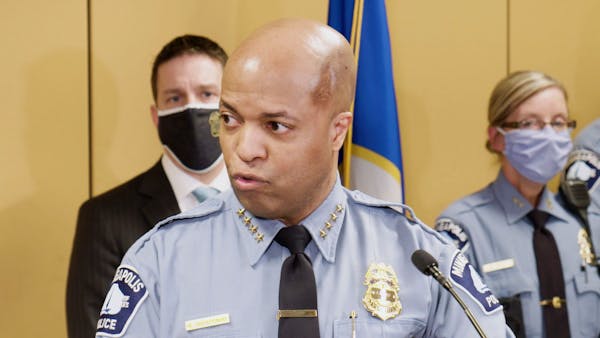Minneapolis has unveiled a long-range plan to revitalize E. 38th Street, well known as the heart of the South Side Black community before the death of George Floyd last year brought global attention to the corner of 38th and Chicago.
This month, the City Council approved 38th Street Thrive , a 10-year development guide for the 38th Street Cultural District, which stretches from Nicollet to Bloomington Avenue. George Floyd Square sits in the heart of that corridor, but the plan calls for a separate, still undetermined approach to its development.
The intersection of 38th and Chicago is now closed to regular vehicular traffic. For the past 10 months, it has been partitioned from the rest of the city by barricades guarded by protesters trying to leverage control of the street in return for 24 demands.
Thrive gathered community feedback for the square but does not recommend a course of action. According to the plan, area residents are concerned about an "unprecedented uptick in violence" including gunshots, theft and lack of police response to 911 calls, but they also want the city to reach a consensus with the protesters who authored the demands and preserve Floyd's memorial.
While the neighborhood works out a long-term strategy for the square, the rest of the cultural district can undergo redevelopment that commemorates the South Side's Black history and uplifts residents, said Council Vice President Andrea Jenkins.
North Minneapolis is the city's best known Black community, but there's a reason St. Peter's African Methodist Episcopal Church was planted on the South Side in 1880, the Minneapolis Urban League opened at 38th Street and 4th Avenue, Prince Rogers Nelson attended Central High, and the Spokesman-Recorder is still reporting from the Central neighborhood after nearly 90 years.
Thrive includes launching a business association and signature street festivals over the next three years, financing a capital fund in years four to six, finding a South Side location for the Minnesota African American Heritage Museum and Gallery, and establishing a land trust for African Americans to purchase homes and commercial property in years seven to 10.
The strategic planning guide has no spending targets. It anticipates future funding from public and private sources.
"We certainly recognize that this has become a multicultural community," Jenkins said. "This is about building bridges, reconnecting communities that have been separated by the freeway, to bring that energy, that economic vitality that we see on the west side of 35W."
Halting displacement is at the heart of the plan, she said.
Thrive highlights the evolution of three longtime community organizations: Sabathani Community Center, the Cultural Wellness Center and Kente Circle.
Sabathani, which hosts youth programs, a food pantry and a clothing shelf at 310 E. 38th St., plans to build 48 units of senior housing with rents at 50% of area median income or less. Total development costs are estimated at $11.7 million.
Capital improvements planned for the center include $2 million to $3 million worth of upgrades to the auditorium, heating and cooling, and the roof.
Kente Circle, a mental health agency whose clients are mostly youth of color, plans to unveil a new Cultural Healing and Training Center as part of a 3,000-square-foot renovation and an 8,000-square-foot expansion of its existing space at 345 E. 38th St.
The Cultural Wellness Center, a community health and economic nonprofit at 2025 S. Portland Av., plans to resurrect the Dreamland Café, which stood at 38th Street and 4th Avenue in the 1930s. One of the first Black-owned businesses in a segregated city, Dreamland and sister club Nacirema ("American" backward) was where local civil rights activists and visiting Black celebrities mingled.
Anthony Taylor of the Cultural Wellness Center said the new Dreamland would be a cooperative incubator for African American entrepreneurs. Its goal, he said, is to fight gentrification by creating economic opportunity for legacy residents while simultaneously upgrading the neighborhood's built environment.
"Minneapolis between 36th and 46th had a significant middle-class Black population that was anchored there until their children in the 1980s began to experience different kinds of economic realities," he said. "Dreamland on 38th is part of a broader concept tied to an African American legacy of economic vitality, which we do not have a narrative for at all."
Project plans include a commercial kitchen, administrative offices and a community event space with rooftop access. The last legislative bonding bill awarded Dreamland $250,000. Construction is slated to begin next spring, Taylor said.
According to local historian Tina Burnside, the once-vibrant South Side neighborhoods declined between the 1980s and 2000s, when crime, crack cocaine and economic hardship closed schools and Black-owned businesses. As white and Black residents moved out, the Hispanic population surpassed both.
Arson and looting that followed the death of Floyd last spring was also heavily concentrated on the South Side. The closure of 38th and Chicago — and its collateral consequences for Black-owned businesses — is an unresolved controversy.
During a February news conference, city officials announced they had dedicated more than $10 million to the area of 38th and Chicago. Most of that money has not been spent in the neighborhood, however.
The $10 million breaks down into $5.5 million for the city's Commercial Property Development Fund, which issues competitive grants to businesses in "economically challenged areas" citywide; $4.75 million to reconstruct the intersection in conjunction with bus station improvements over the next two years; and $150,000 for the division of Race and Equity to provide trauma-informed mental health services. It has not yet been distributed.
Susan Du • 612-673-4028
Minnesota state senator's burglary arrest puts private family drama in the election year spotlight
Minneapolis pushes to recruit more employers for youth internship program

Study: Minnesota's sex offender system is 'failed investment'

